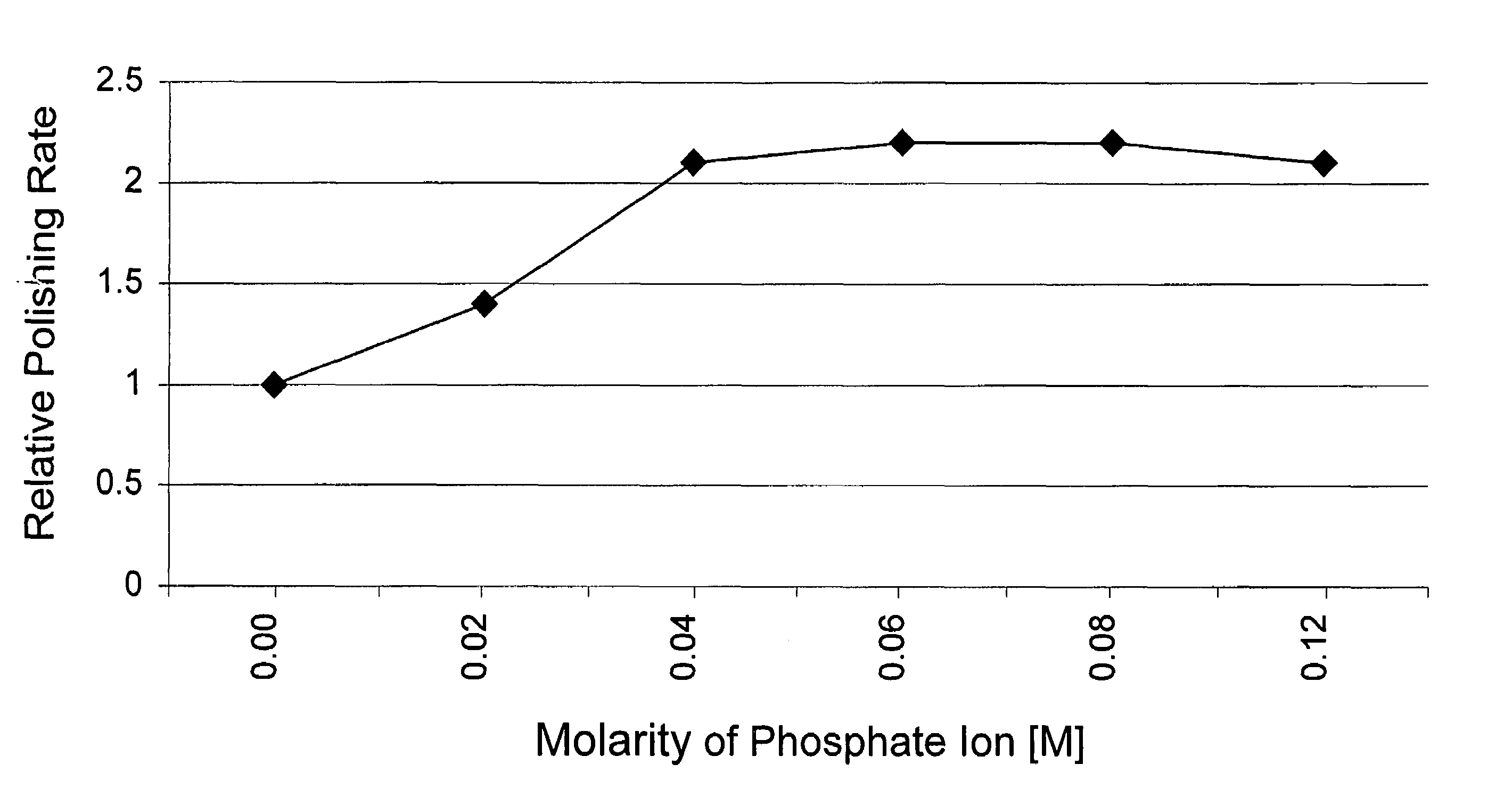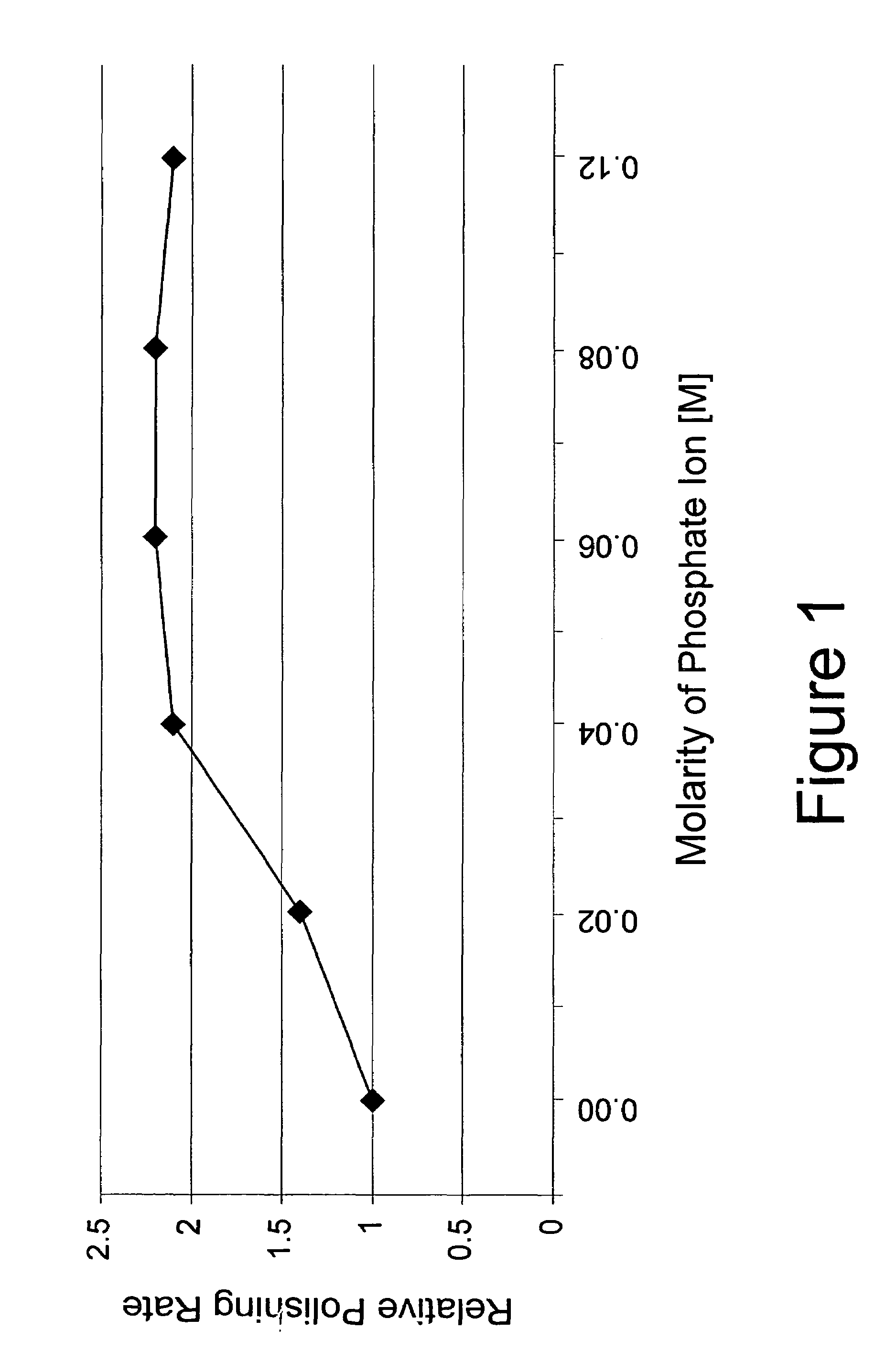Method for polishing a memory or rigid disk with a phosphate ion-containing polishing system
a technology of phosphate ion and polishing system, which is applied in the direction of lapping machines, manufacturing tools, other chemical processes, etc., can solve the problems of low surface defectivity, low polishing rate, and low efficiency of conventional cmp methods or commercially available cmp compositions for planarizing or polishing memory or rigid disks
- Summary
- Abstract
- Description
- Claims
- Application Information
AI Technical Summary
Benefits of technology
Problems solved by technology
Method used
Image
Examples
example 1
[0033]This example illustrates that the polishing rate of a memory or rigid disk achievable by the present inventive method is dependent on the identity of the source of phosphate ion or phosphonate ion in the polishing composition.
[0034]Nickel-phosphor plated memory or rigid disks were polished separately with six different polishing compositions with 4 wt. % silica (specifically, Akzo-Nobel Bindzil 50 / 80 product), 2 wt. % H2O2, and 1 wt. % of either a source of phosphate ion (specifically, ammonium phosphate ((NH4)H2PO4)) or a source of phosphonate ion (specifically, phosphonoacetic acid, 1-hydroxyethylidene-1-diphosphonicacid (i.e., Dequest 2010 product), 2-aminoethyl dihydrogen phosphate, nitrilotris(methylene)triphosphonicacid (i.e., Dequest 2006 product), or diethylenetriaminepenta(methylenephosphonicacid) (i.e., Dequest 2066 product)), such that the polishing compositions had 0.07–0.13 M phosphate ion or phosphonate ion (specifically, 0.073 M, 0.075 M, 0.065 M, 0.07 M, 0.09 M...
example 3
[0037]This example illustrates the significance of the concentration (molarity) of the phosphate ion or phosphonate ion in the polishing composition on the polishing rate of a memory or rigid disk achievable by the present inventive method.
[0038]Nickel-phosphor plated memory or rigid disks were polished separately with five different polishing compositions with 4 wt. % silica (specifically, Akzo-Nobel Bindzil 50 / 80 product), 1.5 wt. % H2O2, and 0.25–1.5 wt. % of a source of phosphate ion (specifically, sodium tripolyphosphate (STP)), such that the polishing compositions had 0.02–0.12 M phosphate ion (specifically, 0.02 M, 0.04 M, 0.06 M, 0.08 M, and 0.12 M, respectively), and wherein each of the polishing compositions had a pH of 2.2. Following use of the polishing compositions, the polishing rate of each composition was determined with the resulting data set forth in Table 3. For comparison purposes, Table 3 also sets forth the relative polishing rate for the control polishing comp...
example 2
[0042]This example further illustrates that the polishing rate of memory or rigid disks achievable by the present inventive method is dependent on the identity of the source of phosphate ion in the polishing composition, as well as the pH of the polishing system.
[0043]Nickel-phosphor plated memory or rigid disks were polished separately with eight different polishing compositions with 4 wt. % silica (specifically, Akzo-Nobel Bindzil 50 / 80 product), 1.5 wt. % H2O2, and 1 wt. % of a source of phosphate ion (specifically, ammonium phosphate ((NH4)H2PO4), potassium phosphate (KH2PO4), potassium pyrophosphate (K4P2O7), or sodium tripolyphosphate (Na5P3O10)), such that the polishing compositions had 0.06–0.09 M phosphate ion (specifically, 0.06 M, 0.07 M, 0.08 M, and 0.09 M, respectively), and wherein the polishing compositions had a pH of 2.5–3.5 (specifically, 2.5, 3.0, or 3.5). Following use of the polishing compositions, the polishing rate of each composition was determined, with the ...
PUM
| Property | Measurement | Unit |
|---|---|---|
| Molar density | aaaaa | aaaaa |
| Molar density | aaaaa | aaaaa |
| Molar density | aaaaa | aaaaa |
Abstract
Description
Claims
Application Information
 Login to View More
Login to View More - Generate Ideas
- Intellectual Property
- Life Sciences
- Materials
- Tech Scout
- Unparalleled Data Quality
- Higher Quality Content
- 60% Fewer Hallucinations
Browse by: Latest US Patents, China's latest patents, Technical Efficacy Thesaurus, Application Domain, Technology Topic, Popular Technical Reports.
© 2025 PatSnap. All rights reserved.Legal|Privacy policy|Modern Slavery Act Transparency Statement|Sitemap|About US| Contact US: help@patsnap.com


